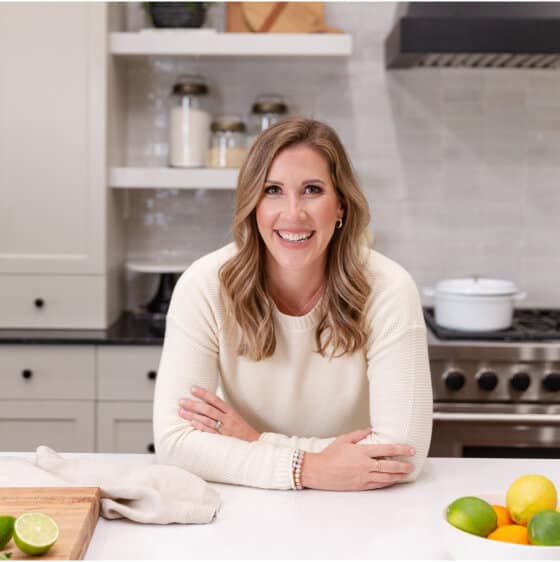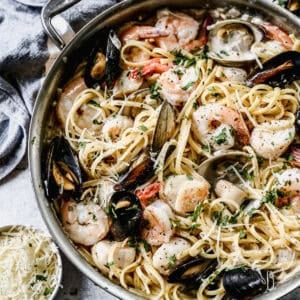It's so easy to make my Baked Salmon recipe at home, and it's just as good (and much less expensive) than a restaurant. We love a garlic butter seasoning, but have tips for using other salmon seasonings as well.

 Any level of cook can master this Baked Salmon recipe.
Any level of cook can master this Baked Salmon recipe.
Nothing beats a perfectly cooked fillet of salmon, and although it's always one of the more expensive items on a menu, it's extremely easy (and much cheaper) to make from home.
My mom regularly baked salmon for Sunday dinner growing up (or flank steak, or a “surf and turf” combination of steak and salmon) and it's one of my favorite meals, with roasted vegetables and wild rice pilaf or risotto and sautéed mushrooms. Delicious!
Plus leftover salmon makes a great meal the next day on top of a salad, or with our salmon bowls.
If you love seafood recipes you must try my Seared Scallops, Shrimp and Grits, Fish and Chips, Cioppino, or Seafood Pasta.
How to bake Salmon:
Rest Salmon on the counter for 20-30 minutes until at room temperature. Pat the fresh with a paper towels to remove excess moisture, then place on a baking tray lined with aluminum foil and sprayed with cooking spray.
Make garlic butter by mixing melted butter, lemon juice, and garlic then spoon over top of the salmon.

Bake at 400°F for 12-15 minutes, or until 120-130 degrees for medium rare/medium (no higher than 140ºF) when checked with a thermometer. It will continue to cook as it rests, so don't overcook it. You can also check salmon for doneness by gently pulling back on the thickest part of the flesh with a fork; it should flake easily and look opaque.
Serve baked salmon fillet with Green Beans, Potatoes Au Gratin, Whole Roasted Cauliflower, Waldorf Salad, Vinegar Coleslaw, or Beet Salad.

Tips for Baking Salmon:
- Buy High Quality Salmon like King Salmon (Chinook), Silver Salmon (Coho), Red Salmon (Sockeye), Pink Salmon (Humpback), or Atlantic Salmon.
- Check For Freshness: First do a quick smell check; fresh salmon should have a mild, salt-water smell (NOT a strong fishy smell). Then gently poke the flesh and it should spring back. Choose bright orange-red hue in the fillet (nothing with darkening flesh around the edges or brown/yellow discoloration). If you buy a whole salmon, look in the eyes of the fish and choose bright, clear eyes, not sunken or cloudy.
- Thaw Frozen Salmon Properly in the refrigerator or place in a sealed bag under running cold water until thawed. Don't use hot water or heat! Let it sit at room temperature before baking.
- Do Not Rinse: Washing your fish is unnecessary and just contaminates the rest of your sink. Any bacteria will be killed during cooking. Water can also break down the flesh of the salmon. Just pat salmon flesh with a paper towels.
- Season – But Not Too Soon: Unlike most meats, we don't want to add the seasoning (especially salt) too early as it will bring the moisture out and leave the salmon dry. Season just before baking.
- Leave skin on for baking as it helps protect the fillet from the heat of the pan and keep the juices and cook evenly. When it's time to serve, slide the spatula under the flesh and it will separate from the skin easily.
- Don't Overcook: Most restaurants serve salmon medium rare, but you can cook it a little longer if you prefer. Ideally, remove the salmon just before it's done as it will continue cooking while it rests. I aim for between 120-130 degrees F (USDA recommends 145 F but I think that is overcooked…you can use your best judgement in this case).
More Salmon recipes:
- Cedar Plank Salmon
- Air Fryer Salmon Bites
- Salmon Bowls
- Salmon Tacos
- Hot Honey Salmon Bowls
- One Pan Baked Salmon and Vegetables
Follow me for more great recipes
Recipe

Baked Salmon
Ingredients
- 1 ½ – 2 lbs salmon fillet (or about six (4oz) portions)
- salt and freshly ground black pepper
Instructions
- Rest salmon. Set salmon on counter and allow it to rest for 20-30 minutes to come to room temperature. Pat with a paper towels. (You can cut one large salmon filet into smaller 3-4 oz portions, or leave it whole).
- Line a sheet pan or any baking tray with a piece of aluminum foil. Lightly spray with non-stick cooking spray. Place fillet on top, skin side down.
- Garlic butter: Melt butter and stir in garlic and lemon juice. Spoon mixture over the flesh of the salmon fillet. You can enclose the aluminum foil around the salmon, if you want (some people prefer it cooked inside a pocket of foil, to make sure it's moist) but you don't have to.
- Bake at 400 degrees F for 12-15 minutes depending on thickness of salmon and desired doneness. USDA recommends 145 degrees F (Remove it a few degrees before desired temperature, as it will continue to cook outside the oven). I always cook my salmon to 120-130 degrees F, for medium rare to medium. The easiest way to check if salmon is done is to use a fork to gently pull back on a section in the thickest part of the filet. The salmon should flake away easily.
Notes
- Cajun: brush salmon filets with olive oil and sprinkle generously with cajun seasoning. Bake as instructed.
- Dill: Season salmon with the garlic butter in the recipe, and bake as directed. Sprinkle some fresh chopped dill on top when it comes out of the oven (or sprinkle generously with dried dill before baking).
Nutrition
Create a FREE Account to save your favorite recipes and create meal plans
Follow Me
*I originally shared this recipe September 2013. Updated October 2019, March 2022 and January 2025.
This post contains affiliate links.

 Any level of cook can master this Baked Salmon recipe.
Any level of cook can master this Baked Salmon recipe.



I made the butter and garlic version tonight and it was easy and so flavorful. This will be my go-to recipe for a quick, easy, delicious dinner.
Well, I am not good at cooking, and I thought this was a good recipe for me to do because of it’s simplicity. Unfortunately, the final result was a tasteless salmon. Well cook but taste and flavors were missing. No salt?
I used the garlic butter sauce tonight. So delicious! The touch of honey counters the lemon perfectly!
We really enjoyed the butter and garlic version. It was delicious and the recipe was easy to follow.
This recipe was shot with my family, I will definitely use it again. I didn’t have fresh parsley so I used dried and also sprinkled a little dry dill, as well. I served with fresh asparagus, white rice, and rosemary bread.
I need all the help I can get with easy but different meals I live by myself
Entrusted our king salmon to this recipe, and turned out great! I made the lemon garlic sauce and added capers. I did cook for less time to get medium rare, about 8 minutes.